The following synopsis is originally a conference paper delivered at the November 2019 Conference of the Australian and New Zealand History of Education Society.
Mapping Local Educated Society 1859-2009: Landscape and Culture in the Mapping Brisbane Education Project
By Dr Neville Buch, MPHA (Qld)
INTRODUCTION
The paper I am presenting today centres in the Mapping Brisbane History Project in two long stabilizing stages. This is educationalist history in the format and forum of in digital mapping and historical sociology. Here we have application of old methods and historiography into new platforms and approaches to both our social science and art form. First, I wish to place the Project into the background of the emerging social science, and then background the methodology with the developing historiography. My argument is that this Queensland project is secure in methodology and philosophy. Queensland in this instance will not lag behind or divert into populist diversions. Then I will explain the details of the Project in three steps. First, I will explain how I have operationalised the basic concept of Mapping Brisbane Education, Stage 6. It will be followed by Stage 7. This Stage, first published in July 2019 as a work-in-progress, looks at the Top 100 Brisbane Institutions of Belief, Thinking, Knowledge, Education, and Scholarship from 1859 to 1959. Finally I will go to Stage 8, Brisbane Changing Landscape and The Educated Society. Here I have mapped Brisbane schools over time, as well drawn upon a detailed sociological study of the former Stephens Shire state schools. I will endeavour to explain a few lessons that can be draw from combining big data and micro studies in the small amount of time I have.
METHODOLOGY
In less than a decade major enterprises in digital mapping for history have emerged. Few mapping projects are being put together for understanding education and its relationship with local communities (informally) and societies & institutions (formally). Chris Johanson et al (2012: 123) explain their own local humanities projects in relation to teaching students ‘to understand, utilize and critique the tools and technologies related to the geospatial/geotemporal web’.
What has been done in the Australasian context is comparatively marginal, but it has made notable impact from work in ‘indigenous mapping’ (McClean 2013: 83-84). Thomas Coomans, Beike Cattoor and Krista De Jonge (2019: 9-14) have demonstrated how mapping methods for historical research is flourishing and the challenges in mapping landscape transformation. Those challenges include understanding the connection of the community, society, and culture to the landscape, and education, the history of education, should be at the centre of that discovery.
HISTORIOGRAPHY
01.A Literature Review Cover Page

Slide2
For the presentation here, I am not going to discuss the historiography of my projects and the methodology for the digital history mapping, but I had a very full document which I completed in June last year, and I will draft out some of these thoughts for the paper.
01.B Sample Sites in MBH-MBE Project

Slide3
Instead, what I will do this afternoon is a very quick twenty-minute tour through the Mapping Brisbane History – Mapping Brisbane Education mapped sites and web pages.
The education of Brisbane from 1859 to 2009 will be illuminated by a selection of sites in three mapping programs.
We have three types of institutions from the 1060 sites in Stages 1-6.
There are seven institutions and societies from 100 sites in Stage 7
There are twelve institutions, societies, and communities from 600 sites in Stage 8
Hopefully, there will be time to look at current work in Stage 9, which turns to the communities of three state primary schools, looking at a sample of 520 former pupils.
- MBH Home Page

Slide4
It all starts here at mappingbrisbanehistory.com.au , and I encourage you, if you wish to know more, to potter around the site. We are now embarking on a whirlwind tour.
THE BASIC CONCEPT OF MAPPING BRISBANE HISTORY (STAGE 1-6)
- MBH Stage 1-6 Website

Slide5
The first stages of the project were only to establish the groundwork of setting out the geographic regions and localised boundaries within those regions
There are five research stages which match the five regions across 63 local study areas.
This was a challenge to the local history societies across Brisbane with whom I worked with to get sites mapped. Local historians tend to divide the city up into districts, but the districts are political devises which paid little attention to the history of the local physical and social geography. Our mapping is more true to the geography discipline.
- MBH Stage 1-6 TML Panel

Slide6
Our mapping has a wider consideration of cultural and social organisation in Brisbane. I am sure would agree that cultural and social organisations are kinds of educational sites. A good example is libraries.
Here we have the Toowong Municipal Library. The heritage listed building is still there but it is no longer the library, and interesting enough, it is now across the small street from the Queensland College of Teachers.
- MBH Stage 1-6 WH Panel

Slide7
Our mapping goes well beyond the heritage methodology. There is a terrible presumption in heritage that if you cannot see it, there is either no history or the history of little importance.
Waldheim Homestead, another heritage-listed building, is still there but its educational and social histories are greatly hidden. It is literally hidden as the modern modification of the ‘Little Ducks Childcare Annerley’. Admittedly, we are seeing contemporary educational history, but the richer history is not valued in the heritage. What is not seen behind the façade is that it was the home of William Stephens, who in 1906-1907 was the (Ministerial) Secretary of Public Instruction and Agriculture.
- MBH Stage 1-6 JPSS Panel

Slide8
Across the street is Junction Park State School. Those who are familiar with my work will know that the school is my major case study. It was a primary education model for the state, and it was closely tied to influential community figures, such as William Stephens, Premier Digby Denham, and William Juster, the Queensland and Federal President of the Master Builders Association.
BELIEF, THINKING, KNOWLEDGE, EDUCATION, AND SCHOLARSHIP FROM 1859 TO 1959 (STAGE 7)
- MBE Stage 7 Website

Slide9
Stage 7 was my first effort to identify different kinds of educational sites, by looking at just the first century of Queensland statehood.
- MBE Stage 7 Map

Slide10
The typology has three levels and combines the collection of the formal educational sites of the schools with informal education in different types of community and social organisations.
- MBE Stage 7 QTC Panel

Slide11
Of particular importance among this audience is the Queensland Teacher College.
- MBE Stage 7 QTC Page

Slide12
It is important to get the sites mapped first and out into the public domain. The research and research publishing is ongoing, and being out in the public domain at various stage of completeness invites participation into educative project.
- MBE Stage 7 WC Panel

Slide13
As a social historian I have been very conscious to be as inclusive in understanding what is meant by education. Women’s College has been part of that inclusive history.
- MBE Stage 7 WC Page
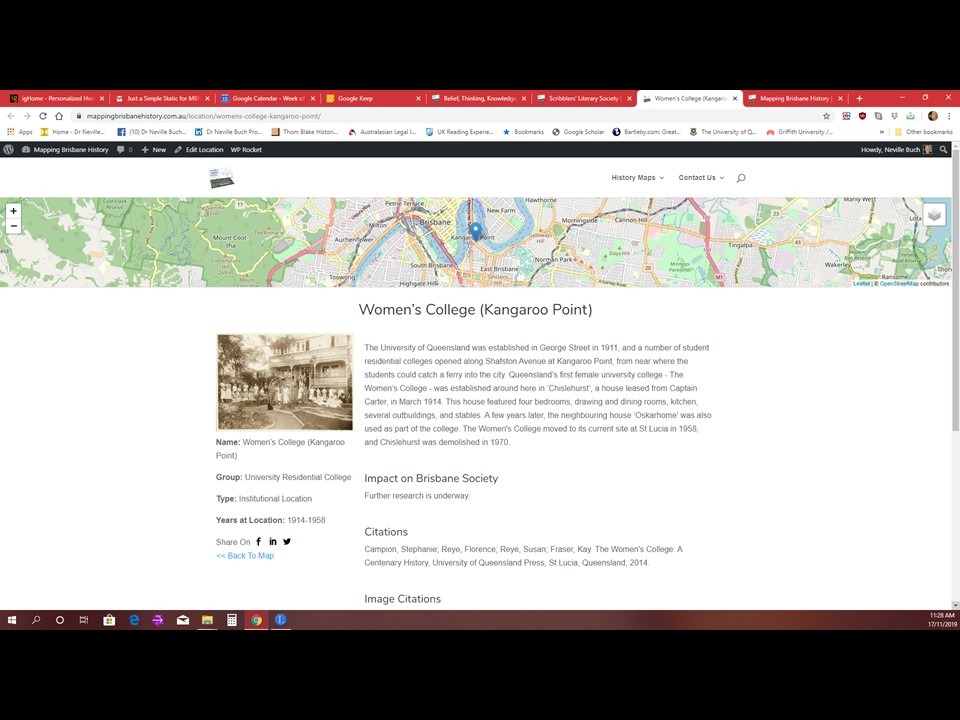
Slide14
I have tried to compose a concise description of each site. Again, this is an ongoing process. There are many mapped sites to fully write up, but even the sites with adequate composition will need to be periodically reviewed and edited.
- MBE Stage 7 SLS Panel

Slide15
There are sufficient numbers of sites closely related to the cultural elite of Brisbane.
- MBE Stage 7 SLS Page

Slide16
My wider research is showing that literary societies in Brisbane played a significant role in the formation of an educated society. As well as the Scribblers’ Literary Society, there was also the Brisbane Literary Circle, formed by the journalist Samuel Wood Brooks, the educationalist Reginald Roe, and Samuel Griffith.
- MBE Stage 7 COEGS Panel
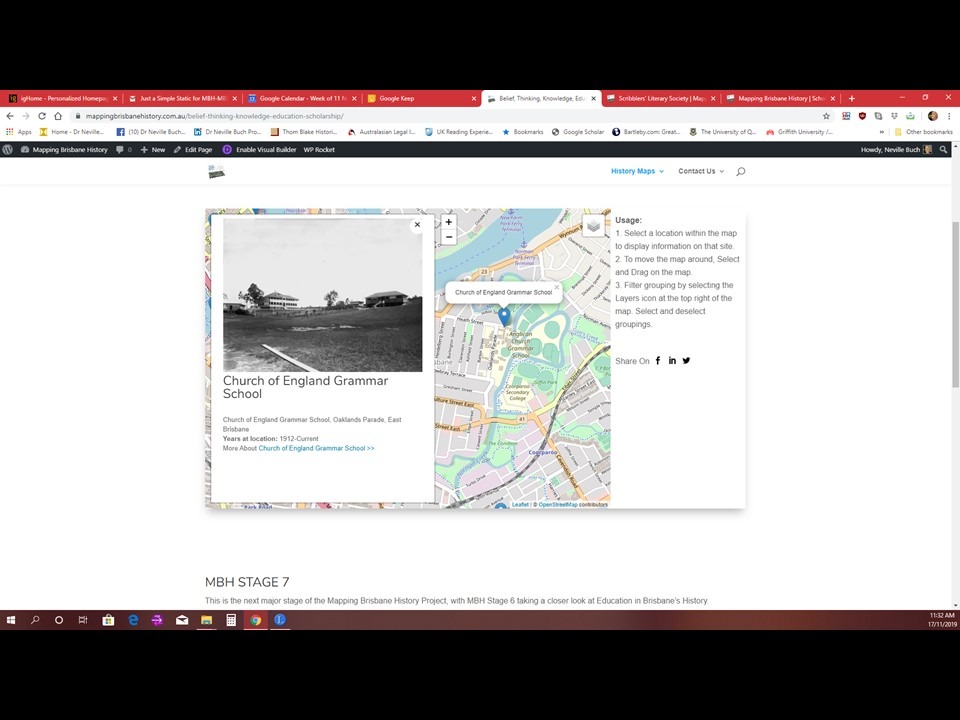
Slide17
The elite school still, unfortunately, gets seen in popular imagination as the beginning and the end of education.
- MBE Stage 7 COEGS Page

Slide18
You will find, though, that I have not been backward to offer critical perspective in the entries. On the Church of England Grammar School, I noted the failure in the institutional response to child abuse.
- MBE Stage 7 AL Panel
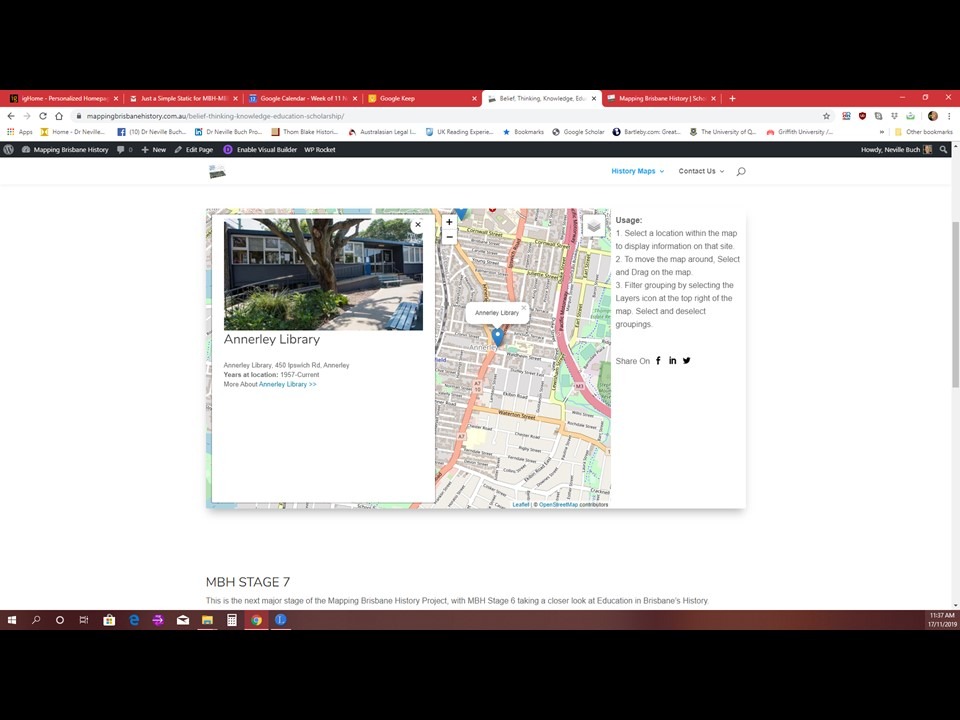
Slide19
In contrast, libraries have come out of the critical gaze much better than schools.
- MBE Stage 7 AL Page

Slide20
The Annerley Library is a very good example of community education. If I am excused for a personal antidote but one that reflects a common experience – my mother took me regularly to the Annerley Library as a young child in the late 1960s. We lived in Coopers Plains and it was a five mile (eight kilometres) trip, having to catch a local bus and a tram. I am sure many of us can testify to the extraordinary influence that municipal libraries have had in our childhood education.
- MBE Stage 7 ROCSN Panel

Slide21
And yet another different but common experience of education is those that come from religious organisations, particularly those places of cultures which are not familiar to the dominant sections of the societies.
- MBE Stage 7 ROCSN Page
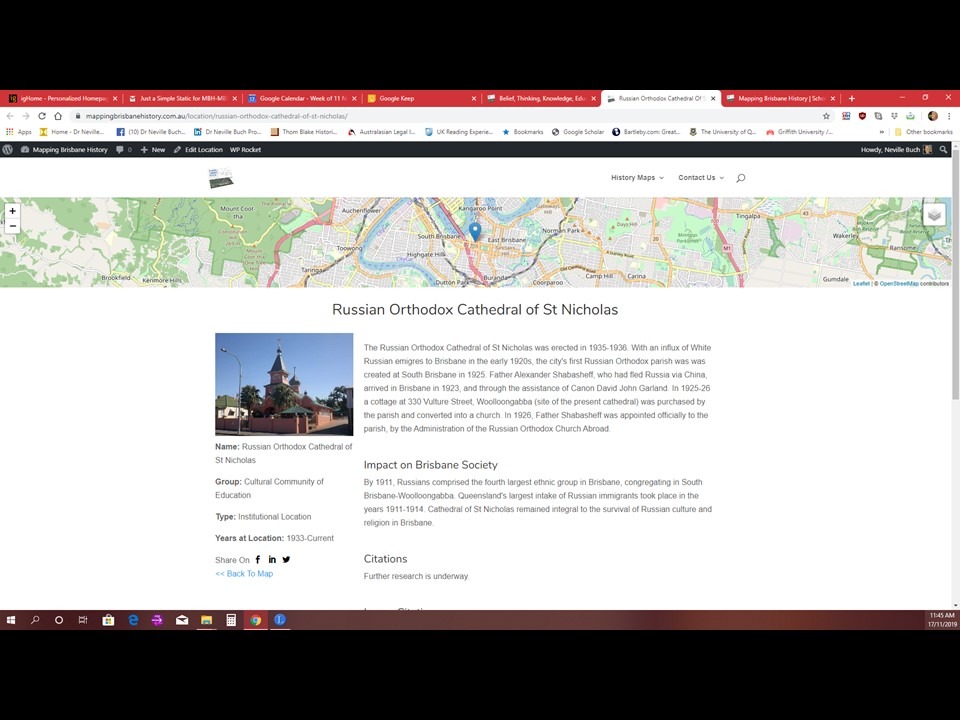
Slide22
So far we have seen at least familiar sites of European cultures and intellectual histories.
- MBE Stage 7 ISHP Panel

Slide23
I have not forgotten many sites outside the European frame. Unfortunately this afternoon I have only time to show you two such sites.
- MBE Stage 7 ISHP Page

Slide24
Many will be surprised to know that Islamic education in Brisbane goes beyond the last century.
BRISBANE CHANGING LANDSCAPE AND THE EDUCATED SOCIETY (STAGE 8)
- MBE Stage 8 Website

Slide25
The next stage in the project is taking the work to a new level. In Stage 7 I was looking at the top 100 foundational sites of education up to 1959. In Stage 8 I have 600 sites across two centuries, with a clearer organisation of the sites into epochs and types of educational forms.
- MBE Stage 8 QUMS Panel

Slide26
On the map you may notice sites in the Brisbane River. Unfortunately I had to throw a hand full of sites into the river merely as a holding pattern. Some of sites of education require deep digging into the research even to get a reasonable and approximate location.
- MBE Stage 8 QUMS Page

Slide27
One of the new features in this map program is that I have added to the entries three geographical descriptions. The first description places the location of the site either, in, on, or outside the historical green belt. The second description identifies the near-by waterways. The third description gives a physical description of the surroundings, particularly in relation to floodable waterways.
- MBE Stage 8 CSOA Panel

Slide28
One of the advantages in our mapping is the ability to identify educational precincts. In this block on Old Cleveland Road are not only the Coorparoo School of Arts, but also the Coorparoo State Infants School, the Bakery School and School of Food, and the Coorparoo Centre for Continuing Secondary Education. Those other sites have disappeared but the School of Arts has remained.
- MBE Stage 8 CSOA Page
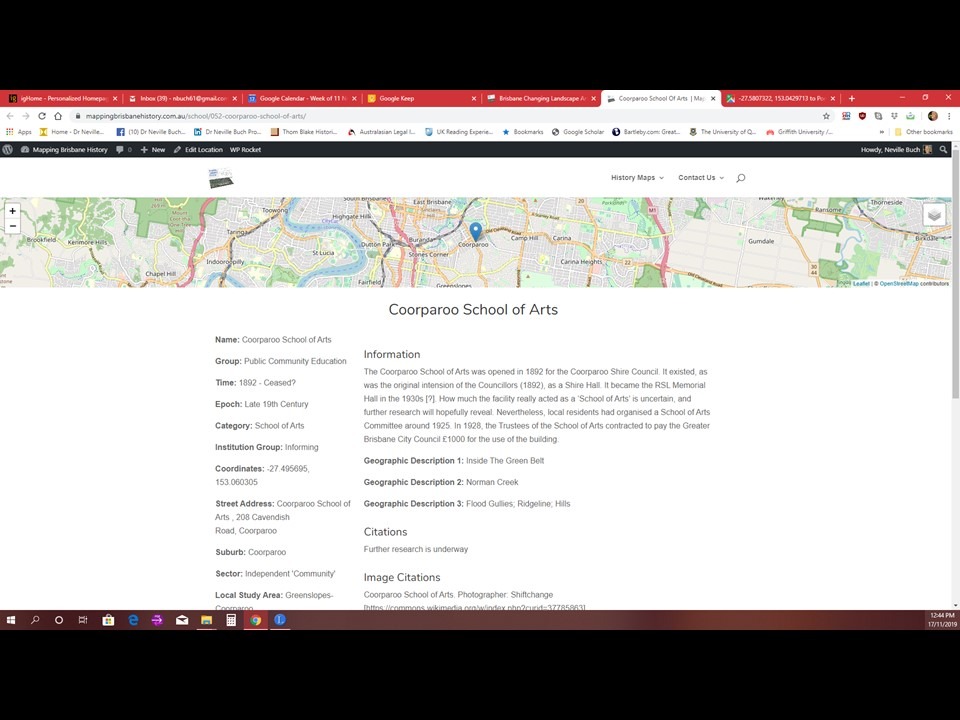
Slide29
But here we have a problem. School of Arts has remained but only as a heritage building with that name. Hence, there is the historical problem that Schools of Art once existed as places of educational discourse. The Brisbane School of Arts in Ann Street was such a model, but when the Schools of Arts were established in the Brisbane suburbs, during the early twentieth century, they were largely reduced to sites of civic meetings, and some with small libraries. The research challenge is then how much educational discourse occurred in the suburban Schools of Arts.
- MBE Stage 8 BTS Panel

Slide30
In many ways cultural and religious societies provided more and high quality education than schools, in certain places and certain times.
- MBE Stage 8 BTS Page

Slide31
The point about education is that we do not have to agree with the content of what is taught to identify the process as education. We can accept that others have been educated, even as we might disagree with conclusions taught, and members of the Theosophical Society would also agree.
- MBE Stage 8 SSC Panel

Slide32
With that thought in mind, we can flip from the informal education of the nineteenth century to the highly regulated and nationalised secondary school education of the twentieth-first century.
- MBE Stage 8 SSC Page

Slide33
Stretton State College represents that twentieth-first century education in a new modern facility among Brisbane Southside’s outer suburbs, the limit of the urban sprawl. On the map above, you will note large sections of the remaining Brisbane forest, Karawatha at the centre, Glider Forest and Parkinson Bushland to left, and Daisy Hill Conservation Park to the right.
- MBE Stage 8 JPC Panel

Slide34
Daisy Hill, where John Paul College is located, is in Logan City, outside of Brisbane, but boundaries never work the way that governments want them to work.
- MBE Stage 8 JPC Page

Slide35
John Paul College is important to Brisbane educationalist history because it represents a new type of education which was produced as an initiative of the local church communities of Logan, with the support of the Brisbane-based Uniting, Anglican, and Catholic educational authorities.
I would like to honour my old friend and colleague, the late Dr Noel Quirke, who wrote the history of John Paul College in its first decade, as well as the histories of the Methodist and Presbyterian Schools Association, and Moreton Bay College.
- MBE Stage 8 JPSS Panel

Slide36
Noel died as the principal historian of educationalist stories around Brisbane, and he inspired me in my production of the book, ‘No Regrets in the Evening of Life’, the story of the Junction Park community. I am very sad that Noel did not get to see that.
- MBE Stage 8 JPSS Page

Slide37
At the moment, the essay entries that I have for the formal schools are generic stories. I have copied and pasted the same templated write-up with some editing. Over time I am adding the specific parts of the story relating to the particular sites.
- MBE Stage 8 GSS Panel

Slide38
Greenslopes State School, formerly Dunellan, is a school close-by to Junction Park.
- MBE Stage 8 GSS Page

Slide39
This is another advantage in our mapping. Schools in the same region, local area, or district, can be compared and their populations can be commonly examined.
- MBE Stage 8 YSIS Panel

Slide40
Yeronga State Infants School, along with the primary grades, is another school in the same Annerley-Stephens district.
- MBE Stage 8 YSIS Page

Slide41
So we get in the same district, schools of different sizes and educational levels, as well as the Catholic convent schools which are also mapped. In the Annerley-Stephens district there was Mary Immaculate in Annerley South, and St Brendan’s in Moorooka.
- MBE Stage 8 AIICS Panel

Slide42
The Aboriginal & Islander Independent Community School is another site outside of the usual European frame.
- MBE Stage 8 AIICS Page

Slide43
It is also a good example where I, as just one historian, will be seeking out further assistance from both the community and other historians. I alone cannot tell all of the stories.
- MBE Stage 8 QBDDI Panel

Slide44
This is particularly true as well for schools in the various movements of education that was disabilities, special, and therapy.
- MBE Stage 8 QBDDI Page
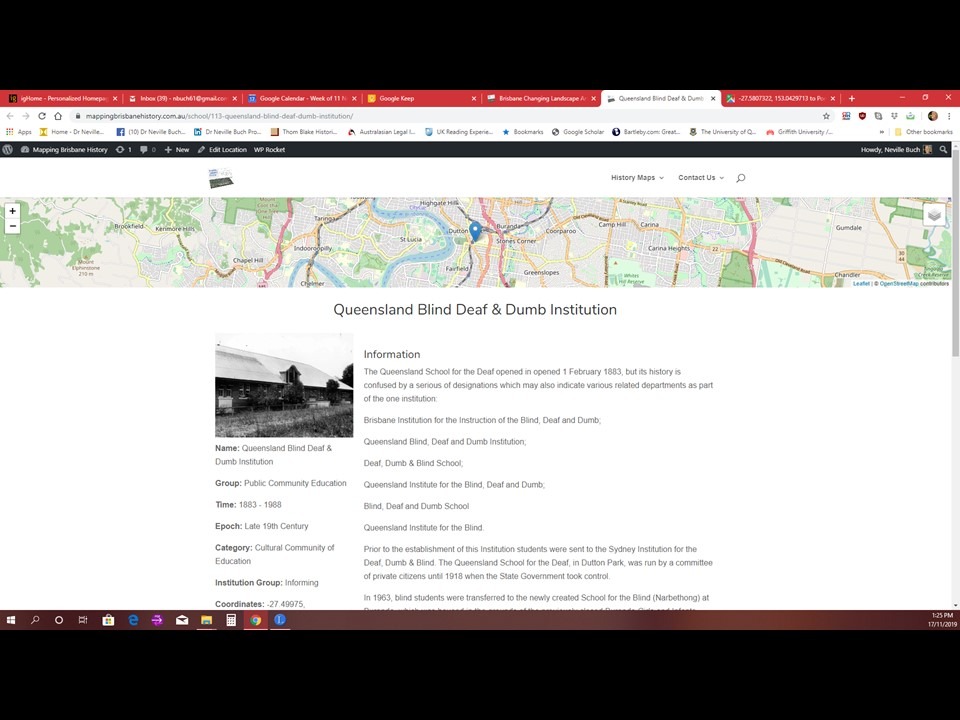
Slide45
Historically we understand how education of these types was once medicalised, and the location of Queensland Blind, Deaf & Dumb Institution was there in the hospital precinct.
- MBE Stage 8 SSS Panel

Slide46
Expertise will have to be sought to deal with the controversies of special versus integrated school models and community attitudes.
- MBE Stage 8 SSS Page

Slide47
The challenges lie in the range of capacities or so-described disabilities. Less than half a kilometre from the Special School in Sunnybank is the Autistic Children’s Therapy Centre in the same suburb.
- MBE Stage 8 IK Panel

Slide48
Kindergarten and early childhood education also has its own set of challenges to do with community expectations.
- MBE Stage 8 IK Page
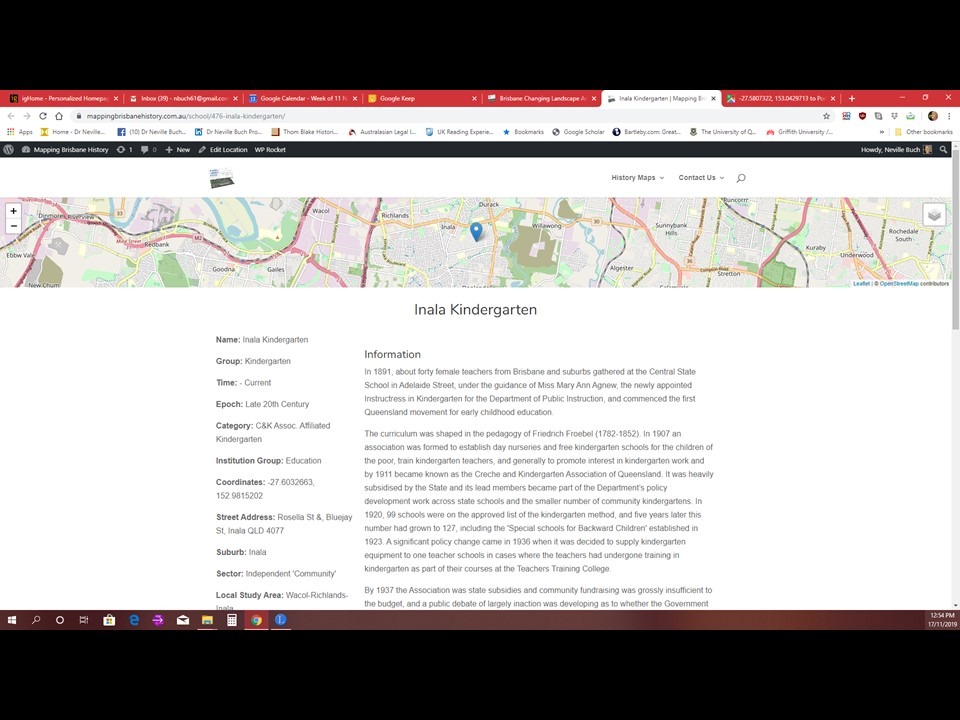
Slide49
In the places like Inala Kindergarten there are other environmental factors. Inala-Durack was a private-community veteran housing and public housing estate from the 1950s. It had all of the challenges of the outlying and under-resourced new town estates. It has a high multicultural character and it has had a certain socio-economic lift in the last four decades. It is the home of Premier Annastacia Palaszczuk.
- MBE Stage 9 Website

Slide50
There may be time to just quickly mention the current work in Stage 9. Here we have 520 former pupils, during the period of 1900 to 1919, from three state schools, which still exist today and are flourishing community-orientated schools: …
- MBE Stage 9 Map

Slide51
…Yeronga State School in the west, Junction Park State School centrally-located in the former Stephens Shire, and Dunellan State School in the east.
- MBE Stage 9 Map Close Up
[Point the schools out: Green is Yeronga, Blue is Junction Park, Red is Dunellan]

Slide52
The 520 is only a statistical sample from a number which must around 10,000. The sites are the home addresses from the Admission Registrars, and so the sites without street numbers they are only approximations at street level.
CONCLUDING REMARKS
It is a big project, and one which will keep me busy for many decades to come. All I really can say in conclusion is that I am hoping for further collaboration among Brisbane educationalists and historians, and of course, further funding.
Thank you.
REFERENCES
Buch, Neville. No Regrets in the Evening of Life: The History of Junction Park State School (1888-2013). Boolarong Press, 2015 (pp. 459).
Coomans, Thomas, et al. “Mapping Landscapes in Transformation: Multidisciplinary Methods for Historical Analysis.” Mapping Landscapes in Transformation: Multidisciplinary Methods for Historical Analysis, Leuven University Press, Leuven, 2019.
Johanson, Chris, et al. “Teaching Digital Humanities through Digital Cultural Mapping.” Digital Humanities Pedagogy: Practices, Principles and Politics, vol. 3, Open Book Publishers, Cambridge, UK, 2012, pp. 121–150.
McClean, Nick. “Being on Country: Githabul Approaches to Mapping Culture.” Transcending the Culture–Nature Divide in Cultural Heritage: Views from the Asia–Pacific Region, edited by Sally Brockwell et al., vol. 36, ANU Press, 2013, pp. 83–100.

Slide53
Neville Buch
Latest posts by Neville Buch (see all)
- Dear grossly, ethically, corrupted - December 21, 2024
- Thoughts with a Professional History colleague on “Artificial Intelligence” - December 21, 2024
- Stephanie M. Lee on “AI by omission”, The Chronicle of Higher Education, Thursday, December 19, 2024 - December 20, 2024
